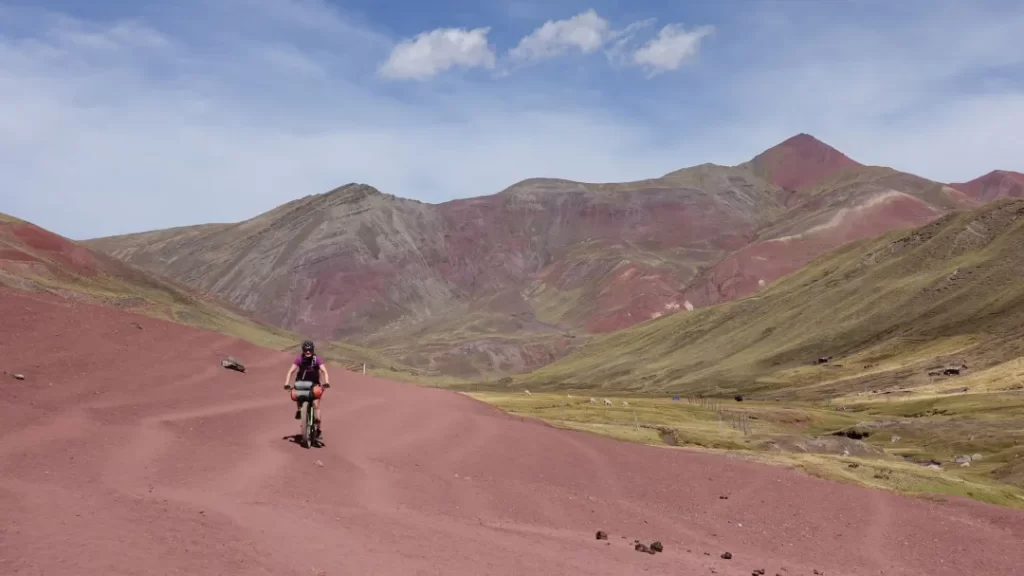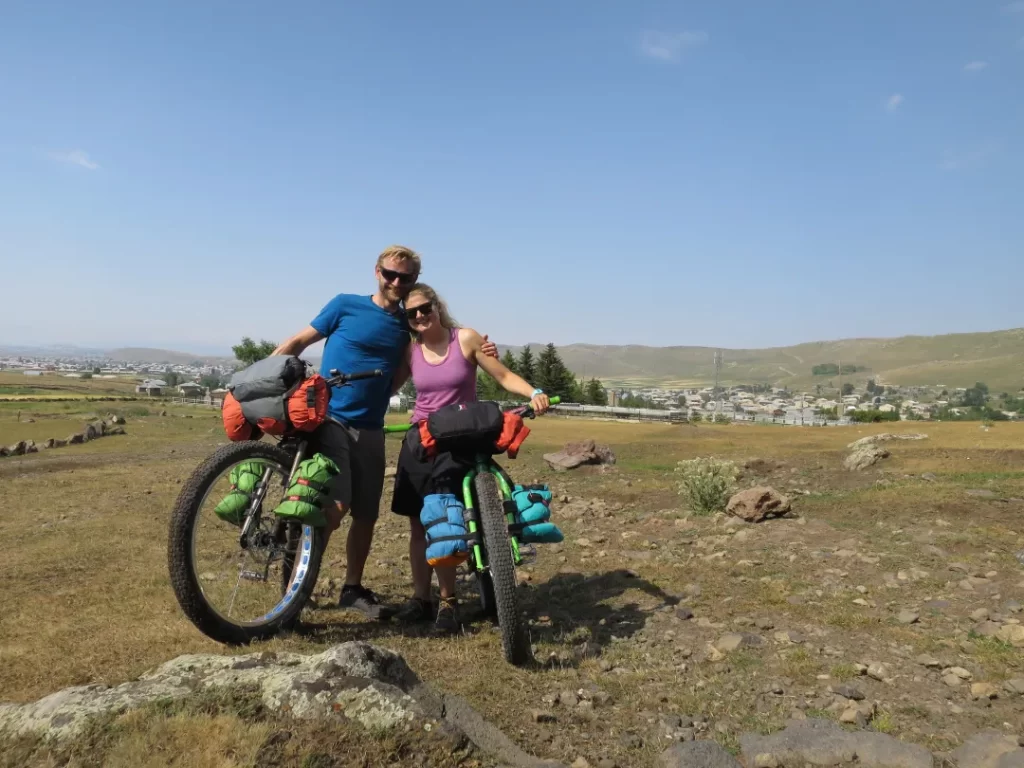Bikepacking
Get an introduction to bikepacking and tips on how to get started yourself.

We cruise down the technical track. Focused, concentrated, happy and happy. Tonight we pitch the tent in the tall grass, by the bend of the river, in the early evening light. We boil water for a cup of hot chocolate while filtering water to drink from the river. We think back to today's hardships on the bike. A beautiful and fun, but also tough track, which has taken us off the beaten path, to where most people never go. Out there where the ceiling is high and where you can hear your own inner voice. We look forward to tomorrow, when we continue even further off the trail, deeper into the breathtaking nature.
We cook over our fire. And we crawl tired and happy into the tent, into the sleeping bag, while the last light leaves the sky. It is early, but we sleep soundly until the sun regains its power.
Bikepacking is many things. It's adventure on a bike. These are technical tracks. These are overnight stays in nature. It's minimalist packaging. It is the meeting with other people and cultures. It's fun and trouble.
Through your skills on the bike, and your light packing, you are able to ride more or less technical and demanding tracks. In addition, you are self-sufficient in terms of food and accommodation. That is that you don't have escort vehicles or depots.
In return, you have the freedom to enjoy nature and the trail to the fullest.


Bikepacking is a fusion of mountain biking, which takes place on a bike designed for riding technical trails, and touring cycling, which takes one far out on an adventure. That is that through bikepacking you go to places where cycling is technically difficult, either in the form of many meters of altitude, long distances or technically demanding tracks. And preferably a combination of it all. You get to the point where a normal touring bike setup has difficulty tackling the terrain.
No one knows exactly where and how bikepacking originated. There have been several movements that started more or less simultaneously. And several different ones will probably claim that they started the phenomenon.
The fact is that much of the equipment today is originally inspired by old-time setups on the military's bicycles. So who started when? It is hard to say…

What is bikepacking?
The basic core is the same in all categories. A capable bike, and a more or less light package, with the most necessary, to cope with the planned trip.
There are as many offers for bicycles and packages as there are bikepackers. But for the sake of the example, I will try to put a bike up in each category, to give an idea of the possibilities.
You can roughly divide bikepacking into three categories:
It is this type of trip that is most reminiscent of regular mountain biking. These are trips that typically involve 1-5 nights. You can drive super easy, because you don't need the great comfort that e.g. clean clothes and toiletries.
The bicycle can e.g. be a fat bike if you are going on sand or snow, or extremely bumpy terrain. It can also be a more typical bikepacking bike with 27.5+ wheels and a damped front fork.
For both bikes, they can be either steel or titanium.
The bags will typically be a frame bag, a seat bag, a front roll. And maybe a 25L backpack.
You want one set of clothes. Freeze-dried food. A light kitchen e.g. Trangia. Sleeping gear and lightweight tent or tarp.
All in all, you want to aim for a bike that weighs a maximum of 20kg dry. The rest in the rucksack, but a maximum of 5 kg.
It goes without saying that when you run a race, you want to run as fast as possible, and thus also as easily as possible.
Depending on the type of race and the terrain, the bike can e.g. be a cross bike with slightly wider tires, drop bars and click pedals.
The frame can be carbon or aluminum if you dare. Steel or titanium will always be my recommendation.
The bags can be half a frame bag, so that the drink bottles can sit in the frame. A seat bag. And a harness with front roll.
Depending on the length of the race, you will again aim for only one set of clothes. And like lycra, with all the advantages it has.
You will try to plan shopping places on the route so that you always have easy-to-digest, pre-produced food with you. And then you typically want to eat a good meal where you shop.
You want to ditch a tent as far as possible, but just have a sleeping bag and mattress, and then find shelter where possible.
It's about cutting away everything unnecessary. If you can get down to 17-18 kg dry total weight, that's good.
Here we are talking about the long bikepacking routes, which stretch more than 1,000 km. Or it is a journey where you find tracks yourself, or combine known tracks. These are also typically trips in countries where you know that the roads are miserable, made of gravel, full of potholes, etc.
The bike is a 29+ without damping, which due to the large diameter of the wheel, rolls well over obstacles. Like the large volume of air in the tires, is ample shock absorption. The bike is a steel frame which has good driving characteristics and which can be welded virtually anywhere in the world, should the accident happen.
There can be many different offers for the bags. But you typically need a little more space. So either you want to put a luggage carrier at the back or at the front. Here you will be able to have either a small backpack with a flat back lying down, or an upright bag. You can have space for micro panniers, or drybags, on the side of the luggage carrier. Just as you can mount drybags on the front fork. There will still be frameback and frontroll. And probably also all the small bags you can find room for, in all available places on the frame.
You probably want to cook a lot of food yourself, which is why you have a multifuel burner with you. You need 2 or 3 sets of base layer clothing. This means underwear, t-shirts and socks. But only one set of each outer layer. You will probably go through several seasons, and will therefore need slightly warmer clothes. And you need some toiletries to take care of yourself.
You want to aim to buy as little food at a time as possible, but often you cycle for several days without shopping opportunities, so you must have a flexible setup so that you can have both a lot and a little food.
You should be able to land on a dry total weight of around 35 kg.

Get started yourself

Use what you already have as much as possible. Buy only what you know you absolutely need. And when you buy something, invest once and for all in the best you can think of, so that you have good equipment for many years to come.
If you already have a mountain bike, use it for the first few rides. Any mountain bike can be used for bikepacking.
If you don't have one, and aren't ready to invest heavily in your dream bike yet, find a used hardtail, in good condition, at a reasonable price.
You can go a long way with a little ingenuity when it comes to bags on the bike.
Start by strapping a drybag onto the handlebars. You can also strap a drybag under the saddle, like a seatbag. Instead of a framebag, you can go a long way with using the bottle holders, and then strap a tent/drybag under the top tube of the bike.
You can buy cages to put on the front fork cheaply, and in these you can have drybags sitting.
If you have the option of a luggage carrier, it is also an easy and cheap way to have a bag or dry bag with you. But avoid panniers at all costs, as they cannot withstand riding on rough terrain, and they will make your bike far too heavy at the back and unmanageable.
On many bicycles, there is also room to tape the extra hose and possibly tire, fixed under the down tube of the bike. It gives more space in the bags and keeps the weight close to the center.
In general, it is important to distribute the weight equally on the bike, in relation to front and rear. And it largely applies to getting heavy things, low down in the center. That is, at the crank. And last but not least, the bike must not be too wide. You still have to be able to drive in narrow places.
In this way, you have the best opportunities to handle the bike relatively freely on the technical tracks.
Feel free to start out by driving a few shorter trips, on an overnight stay or two, where you get to try out the equipment and can adjust it afterwards.
